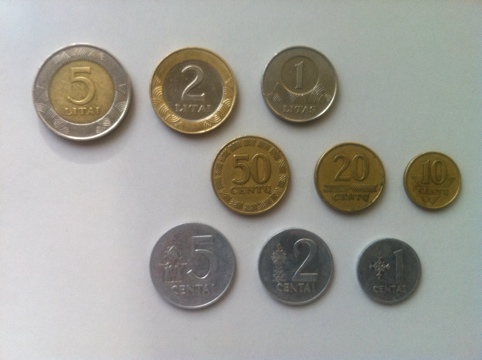In the U.S., we normally deal with only four coins: the quarter, dime, nickel and penny. We do have dollar and half-dollar coins, but it’s rare to see them. In Lithuania, there are nine coins: 5 litai, 2 litai, 1 litas, 50 centų, 20 centų, 10 centų, 5 centai, 2 centai and 1 centas. (Another grammar oddity in case you noticed: it’s centų in some instances because multiples of 10, and numbers in the teens, take the genitive case.)
Counting out change can take a while if you’re not accustomed to the system of size graduations and weights among the coins.
The 1, 2 and 5 litai coins are the heaviest, and they are graduated in size. The 5 is bronze in color rimmed with silver; the 2 is silver rimmed with bronze; the 1 is all silver. The 50, 20 and 10 centų coins are all bronze and are also graduated in size as a group, as are the 5, 2 and 1 litai, which are all silver. Sounds reasonable so far, right?
The 5 litai coin is the largest of all, so no problem. Here’s why I get confused: Coin weights vary a bit, but size variations are minute, and there are size overlaps among the groupings of denominations. The 2 litai is the same size as the 5 centai. The 1 litas is the same size and color as the 2 centai. The 50 centų is between the 1 litas and 2 litai (and therefore between the 5 centai and 2 centai) in size. The 20 centų is between the 2 centai and 1 centas in size. The 10 centų is the smallest coin of all. Maybe they were thinking of our dime when they decided on that. Oi!
The distinctions are even harder to discern when have a big pile in your hand and you’re being asked for exact change when there’s a long line of other customers behind you. I hadn’t experienced this in Vilnius, because it seemed that most everything was rounded up to the litas. It’s been a bit different in Kaunas.
A couple weeks ago I was getting lunch at Lietuviški Patekelai, a quick-moving, cafeteria-style restaurant at the head of Laisvės Alėja. When I got to the register, I proffered a 20 litų note for an 8-and-change litai meal. The cashier asked if I had exact change. I should have said no, but I was distracted by the conversation I was having with my lunch companion. I fished out several days’ accumulation of coins from my bag.
The reason I had so much change was precisely because I didn’t want to appear slow or stupid in these situations so I had been using paper money as much as possible whenever centų (or centai) were involved. Well, I was now holding up the line fumbling with an unnecessarily huge handful of change. The cashier finally said, in Lithuanian, “Put it down, I’ll do it.”
I slid the mountain of coins onto the dish that’s kept by the register. One rarely hands cash or credit cards to anyone; bills and payments are placed–and receipts and change received–on a dish or in a container specifically for that purpose. The cashier speedily counted out what was needed and put the rest of it back on the plate. I said, “Ačiū,” scooped up what was left of my change and slunk away.
My latest strategy is to leave anything I have that’s less than 20 centų with the tip when eating out. It’s worked well so far. Maybe too well. It took me a week to accumulate enough small change to make the photo.

